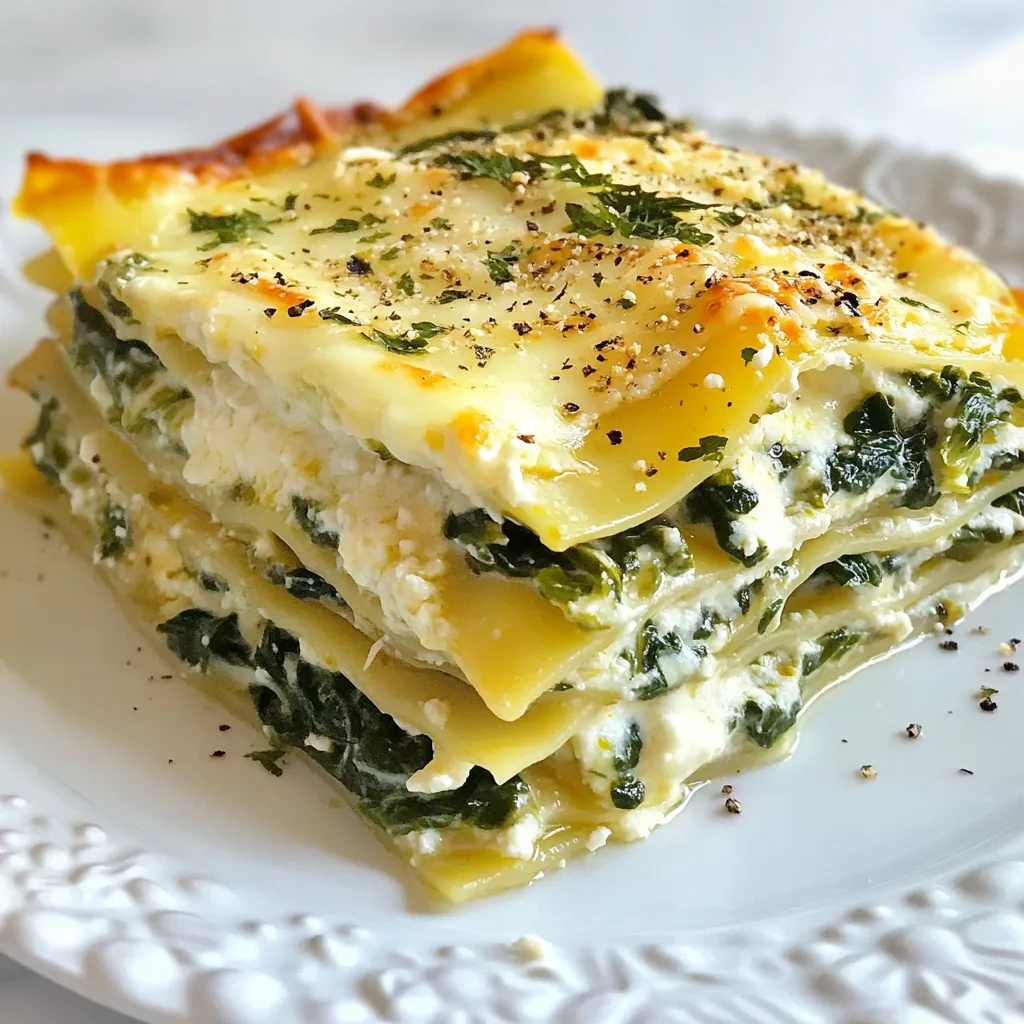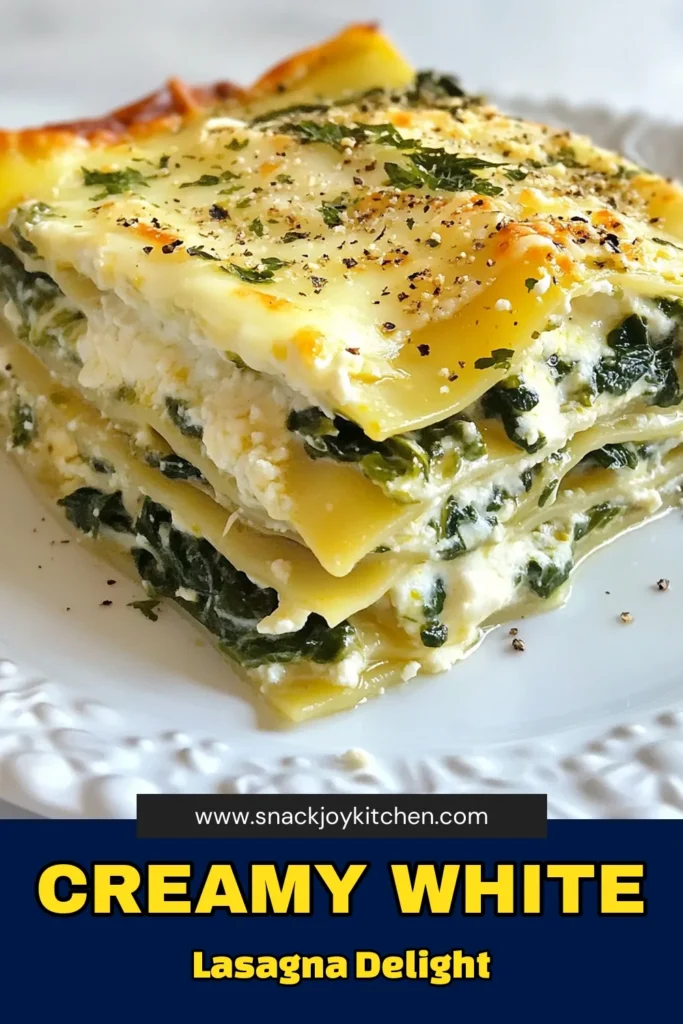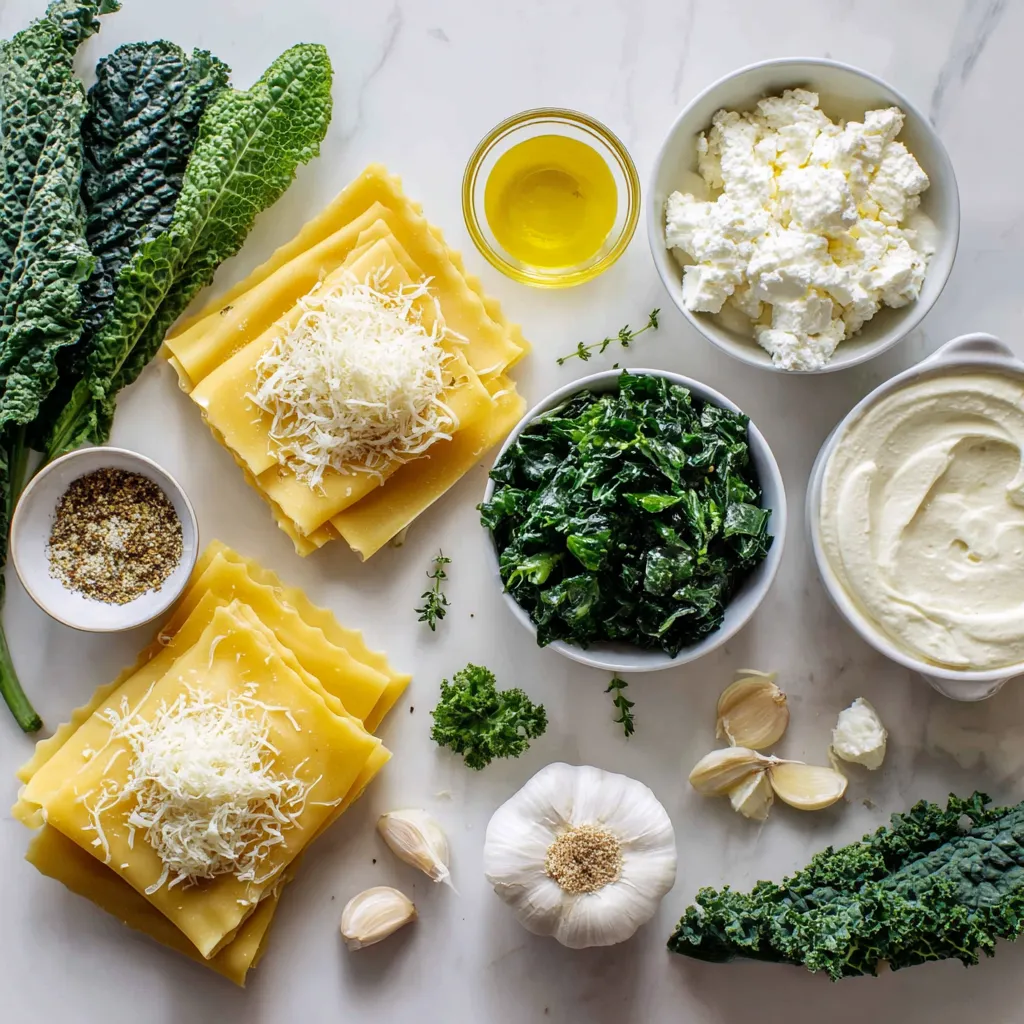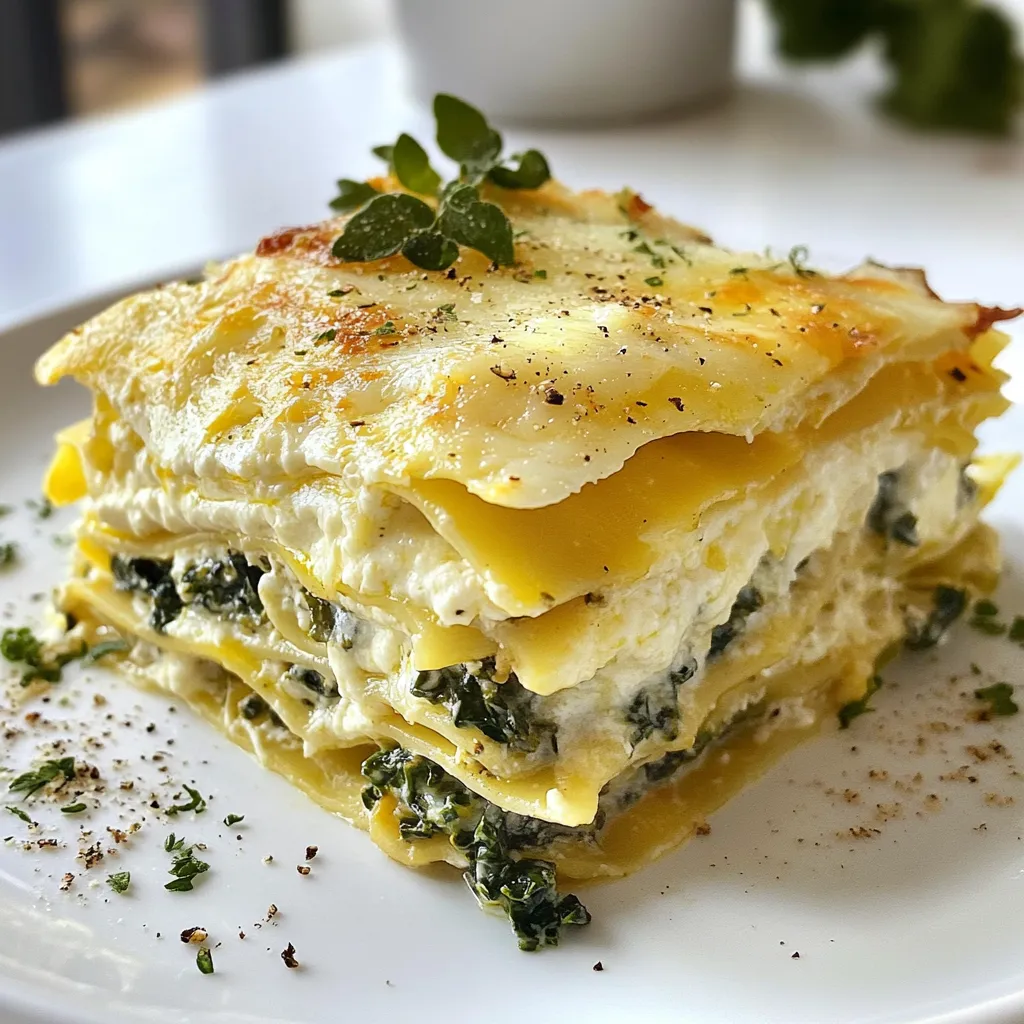WANT TO SAVE THIS RECIPE?
Looking for a cozy dish that warms both your belly and heart? My White Lasagna with Garlicky Greens delivers delightful layers of creamy goodness and vibrant greens in every bite. This recipe combines simple ingredients into a comforting meal perfect for any night. I’ll walk you through each step, helping you create a dish that’s not only delicious but also visually stunning. Get ready to impress your family at the dinner table!

Why I Love This Recipe
- Deliciously Creamy: This lasagna features a rich béchamel sauce that perfectly complements the creamy ricotta and gooey mozzarella, creating a luxurious bite every time.
- Nutritious Greens: The addition of spinach and kale not only adds a pop of color but also boosts the nutritional value, making it a wholesome meal.
- Easy to Assemble: With straightforward layering, even novice cooks can create a stunning dish that looks as good as it tastes.
- Perfect for Any Occasion: This creamy white lasagna is versatile enough for weeknight dinners or special gatherings, delighting everyone at the table.
Ingredients
Main Ingredients Overview
– 12 lasagna noodles
– 2 cups ricotta cheese
– 3 cups shredded mozzarella cheese
– 1 cup grated Parmesan cheese
– 4 cups fresh spinach, tightly packed
– 1 cup kale, finely chopped
– 4 cloves garlic, finely minced
– 2 tablespoons extra-virgin olive oil
– 1 teaspoon ground nutmeg
– Salt and freshly ground black pepper to taste
– 3 cups béchamel sauce (store-bought or homemade)
Each ingredient plays a key role in the dish. The lasagna noodles serve as the base and hold everything together. Ricotta adds creaminess and a rich texture. Mozzarella melts beautifully and provides a gooey layer of cheesy goodness. Parmesan offers a sharp taste that enhances the overall flavor. Spinach and kale bring vibrant color and nutrients. Garlic adds a fragrant punch, while olive oil enriches the dish. Nutmeg adds warmth, and salt and pepper enhance all flavors.
Optional Ingredient Additions
You can customize this lasagna to suit your taste. Try adding extra vegetables like mushrooms, zucchini, or bell peppers for more flavor and nutrition. For protein, consider cooked chicken, turkey, or even shrimp. If you want to mix up the cheeses, try goat cheese or fontina. These variations can change the dish and make it your own.
Tools and Equipment Needed
To make this dish, you need a few essential tools. A large pot is great for boiling the noodles. A skillet helps prepare the garlicky greens. You will also need a 9×13-inch baking dish; glass or ceramic works best for even baking. A spatula or spoon is handy for layering the ingredients. Make sure you have measuring cups and spoons for accuracy. These tools will help you create this tasty comfort dish smoothly.

Step-by-Step Instructions
Preparation Steps
1. Preheat the oven to 375°F (190°C). This step makes sure your lasagna cooks evenly.
2. Boil the noodles: Bring a large pot of salted water to a boil. Cook the lasagna noodles until they are al dente, which usually means about 8-10 minutes. Drain them and lay them flat on a clean kitchen towel. This keeps them from sticking together.
3. Prepare garlicky greens: In a large skillet, heat 2 tablespoons of extra-virgin olive oil over medium heat. Add 4 minced garlic cloves and cook for about 1 minute. Stir the garlic until it smells nice, but don’t let it burn.
4. Add 4 cups of fresh spinach and 1 cup of chopped kale to the skillet. Season with salt and freshly ground black pepper. Cook until the greens are wilted, about 3-4 minutes. Remove from heat and let them cool slightly.
Layering the Lasagna
1. Assemble the first layer: Take a 9×13-inch baking dish. Spread a thin layer of béchamel sauce across the bottom. This helps keep the noodles from sticking.
2. Layer the noodles: Place 4 lasagna noodles over the sauce. Lay them slightly overlapping.
3. Add the filling: Spread half of the 2 cups of ricotta cheese over the noodles. Next, add half of the garlicky greens, followed by a layer of 3 cups of shredded mozzarella cheese.
4. Repeat the layering process: Add another layer of 4 noodles. Spread the remaining ricotta cheese, the rest of the garlicky greens, and another layer of mozzarella cheese on top.
5. Finish with noodles: Place a final layer of noodles on top. Pour the remaining béchamel sauce over this layer. Make sure all noodles are well covered.
6. Top it off: Sprinkle the top with 1 cup of grated Parmesan cheese and a dash of nutmeg. This gives a nice flavor and aroma.
Baking Instructions
1. Cover and bake: Cover the baking dish with aluminum foil to keep the cheese from burning. Bake it in the preheated oven for 25 minutes.
2. Uncover and finish baking: Remove the foil and bake for another 15-20 minutes. The top should be golden and bubbly when done.
3. Check doneness: To know if the lasagna is done, look for a golden top. The cheese should be melted, and the sauce should be bubbling around the edges.
Tips & Tricks
Perfecting the Aesthetic
To make your white lasagna look stunning, think about presentation. When you serve it, use a sharp knife to cut neat squares. This helps keep the layers intact. Place each piece on a white plate to show off the colors. You can add a sprinkle of freshly chopped parsley on top for a pop of color. A light dusting of extra Parmesan cheese also adds a nice touch. Serving it with a crisp side salad makes the dish feel complete.
Flavor Enhancements
For added flavor, consider spices like thyme or oregano. These herbs blend well with the creamy béchamel sauce. You can also mix in a pinch of red pepper flakes for some heat. If you want a richer sauce, try adding a bit of grated nutmeg to the béchamel. This will deepen the flavor profile and enhance the overall dish.
Cooking Techniques
To keep your lasagna moist, cover it with foil for the first part of baking. This prevents it from drying out. Remove the foil towards the end to allow the top to become golden and bubbly. If you have leftovers, reheating can be tricky. Place the lasagna in a baking dish and cover it with foil. Heat it at a low temperature, around 325°F. This will help retain the creamy texture and prevent it from becoming dry.
Pro Tips
- Use Fresh Ingredients: For the best flavor and texture, opt for fresh spinach and kale instead of frozen. Fresh greens will provide a vibrant taste and a lovely bite to your lasagna.
- Make Your Own Béchamel: While store-bought béchamel is convenient, homemade béchamel sauce is richer and more flavorful. It’s worth the extra effort for a truly luscious lasagna.
- Let It Rest: After baking, allow your lasagna to rest for at least 10 minutes before slicing. This will help the layers set and make serving much easier.
- Experiment with Cheeses: Feel free to mix in different types of cheese, such as fontina or goat cheese, for added depth of flavor. Just ensure to maintain a balance to prevent overpowering the dish.

Variations
Vegetarian Alternatives
You can replace cheese with different options. Try using cashew cheese for a nutty taste. You might also enjoy using a mix of vegan cream cheese and nutritional yeast. For greens, consider using Swiss chard or collard greens. Both add great flavor and texture, making your dish even more colorful.
Gluten-Free Options
For gluten-free noodles, look for rice or corn-based options. They work well and still hold together nicely. When making béchamel sauce, use gluten-free flour like almond or coconut flour. This swap keeps the sauce creamy without gluten.
Protein Additions
Adding protein can make your lasagna heartier. Ground turkey or chicken works great. You can also add shrimp or crab meat for a seafood twist. Balance flavors by using herbs like basil or oregano. They will enhance the taste without overwhelming your dish.
Storage Info
Refrigeration Guidelines
To store leftover lasagna, let it cool first. Then, cut it into portions. Place each piece in an airtight container. You can also wrap it tightly in plastic wrap or aluminum foil. This helps keep it fresh and prevents drying out. Make sure to store it in the fridge within two hours of baking. It will stay good for about 3 to 5 days.
Freezing Instructions
To freeze lasagna, first, let it cool completely. Then, cut it into portions. Wrap each piece in plastic wrap or aluminum foil. After that, place the wrapped pieces in a freezer-safe bag or container. This keeps them fresh for up to three months. When you are ready to eat, take a piece out. Thaw it in the fridge overnight. Then, reheat it in the oven at 350°F (175°C) until hot, about 20-30 minutes.
Shelf Life
In the fridge, your white lasagna will last about 3 to 5 days. In the freezer, it can stay good for up to three months. Signs of spoilage include a sour smell, mold, or a change in color. If you see any of these signs, it’s best to throw it away.
FAQs
Can I make this lasagna ahead of time?
Yes, you can make this lasagna ahead of time. Prepare it fully, then cover and refrigerate for up to two days. This helps the flavors blend. Just remember to bake it longer if it is cold from the fridge.
Can I substitute the béchamel sauce?
Yes, you can use a few alternatives for béchamel. For a quick option, try using cream cheese mixed with a little milk. You can also use store-bought Alfredo sauce or even a simple white sauce made with butter and flour.
What’s the best way to reheat lasagna?
To reheat lasagna, preheat your oven to 350°F (175°C). Cover the dish with foil to keep it moist. Bake for about 20 minutes or until hot throughout. You can also reheat individual portions in the microwave for a quicker option. Just add a few drops of water to keep it from drying out.
This blog post covered how to make a great lasagna. We discussed key ingredients and how each one adds flavor. I shared optional extras and helpful tools for cooking. You also learned step-by-step instructions for preparation, layering, and baking. There are many tips to enhance taste and presentation. We explored variations like vegetarian and gluten-free options. Finally, I provided storage tips to keep your lasagna fresh. With this guide, you can create a delicious lasagna that everyone will enjoy. Get cooking and enjoy every bit
Luscious Creamy White Lasagna with Garlicky Greens
A rich and creamy lasagna layered with garlicky greens and three types of cheese.
Prep Time 30 minutes mins
Cook Time 45 minutes mins
Total Time 1 hour hr 15 minutes mins
Course Main Course
Cuisine Italian
Servings 8
Calories 450 kcal
- 12 noodles lasagna noodles
- 2 cups ricotta cheese
- 3 cups shredded mozzarella cheese
- 1 cup grated Parmesan cheese
- 4 cups fresh spinach, tightly packed
- 1 cup kale, finely chopped
- 4 cloves garlic, finely minced
- 2 tablespoons extra-virgin olive oil
- 1 teaspoon ground nutmeg
- to taste Salt and freshly ground black pepper
- 3 cups béchamel sauce (store-bought or homemade)
Preheat the oven to 375°F (190°C).
Bring a large pot of salted water to a boil and cook the lasagna noodles according to package instructions until they are al dente. Drain the noodles and lay them flat on a clean kitchen towel to prevent sticking.
In the meanwhile, prepare the garlicky greens: In a large skillet, heat the extra-virgin olive oil over medium heat. Once hot, add the minced garlic and sauté for about 1 minute, or until fragrant, making sure not to burn it.
Add the fresh spinach and chopped kale to the skillet with the garlic. Season generously with salt and freshly ground black pepper. Cook, stirring occasionally, until the greens are wilted and tender, approximately 3-4 minutes. Remove from heat and set aside to cool slightly.
Now, assemble the lasagna: Spread a thin layer of béchamel sauce across the bottom of a 9x13-inch baking dish. Place 4 lasagna noodles over this sauce, slightly overlapping them.
Spread half of the ricotta cheese evenly over the noodles, followed by half of the garlicky greens, and then a generous layer of mozzarella cheese.
Repeat the layering process: Add another layer of 4 noodles, then spread the remaining ricotta cheese, the remaining garlicky greens, and another layer of shredded mozzarella cheese.
Complete the lasagna with a final layer of noodles on top. Pour the remaining béchamel sauce over this layer, ensuring that all noodle surfaces are well covered.
Sprinkle the top with the grated Parmesan cheese and a dash of nutmeg for a fragrant finish.
Cover the baking dish with aluminum foil to prevent the cheese from burning and bake in the preheated oven for 25 minutes. Remove the foil and continue baking for another 15-20 minutes, or until the top is beautifully golden and bubbly.
Once done, take the lasagna out of the oven and allow it to cool for about 10 minutes before slicing into squares and serving.
For a touch of elegance, garnish each serving with freshly chopped parsley and a light sprinkle of additional Parmesan cheese. Consider serving the lasagna with a crisp side salad for a well-rounded meal experience.
Keyword cheese, greens, lasagna, vegetarian
WANT TO SAVE THIS RECIPE?





